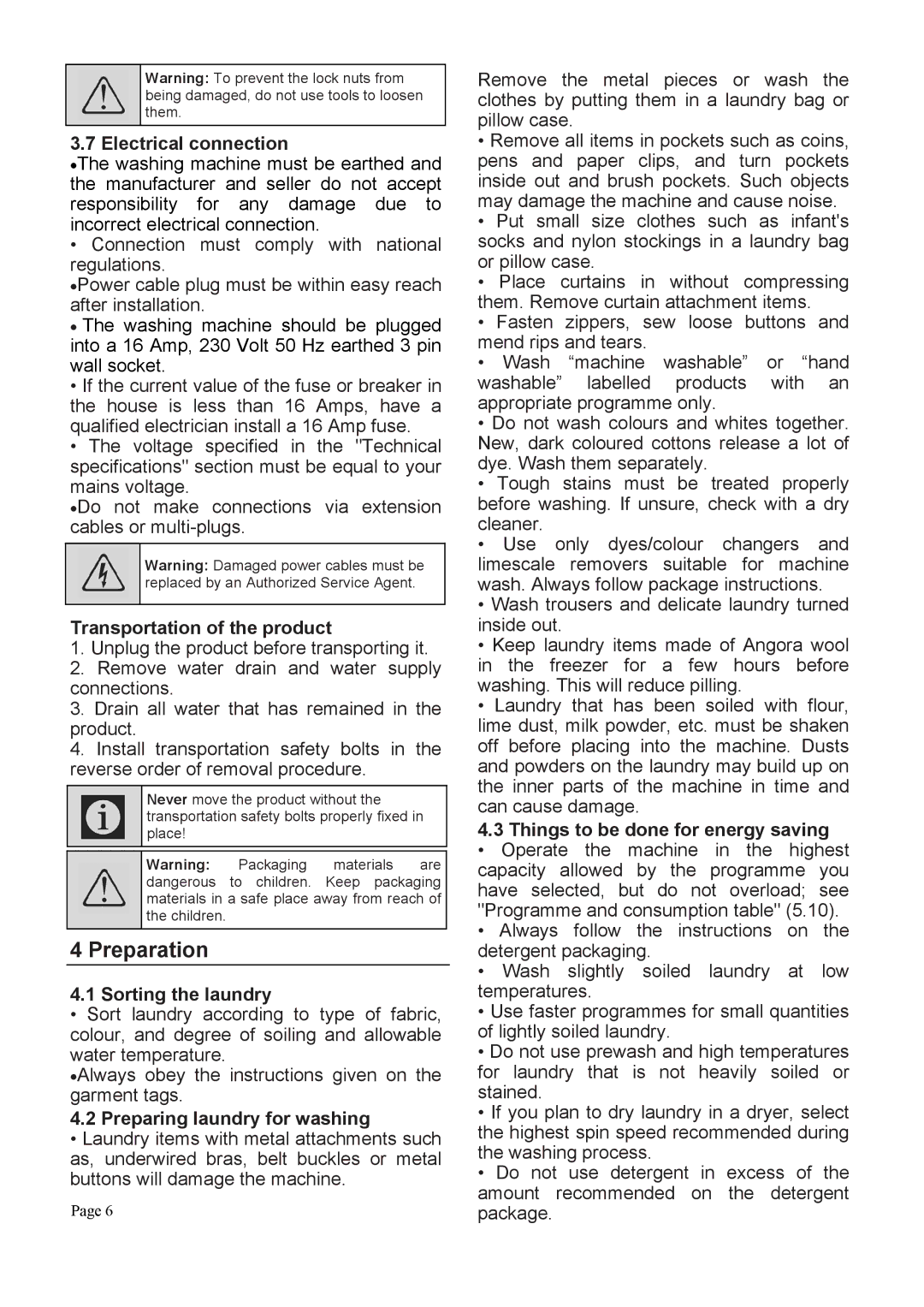
Warning: To prevent the lock nuts from being damaged, do not use tools to loosen them.
3.7 Electrical connection
•The washing machine must be earthed and the manufacturer and seller do not accept responsibility for any damage due to incorrect electrical connection.
•Connection must comply with national regulations.
•Power cable plug must be within easy reach after installation.
•The washing machine should be plugged into a 16 Amp, 230 Volt 50 Hz earthed 3 pin wall socket.
•If the current value of the fuse or breaker in the house is less than 16 Amps, have a qualified electrician install a 16 Amp fuse.
•The voltage specified in the "Technical specifications" section must be equal to your mains voltage.
•Do not make connections via extension cables or multiplugs.
Warning: Damaged power cables must be replaced by an Authorized Service Agent.
Transportation of the product
1.Unplug the product before transporting it.
2.Remove water drain and water supply connections.
3.Drain all water that has remained in the product.
4.Install transportation safety bolts in the reverse order of removal procedure.
Never move the product without the transportation safety bolts properly fixed in place!
Warning: Packaging materials are dangerous to children. Keep packaging materials in a safe place away from reach of the children.
4 Preparation
4.1 Sorting the laundry
•Sort laundry according to type of fabric, colour, and degree of soiling and allowable water temperature.
•Always obey the instructions given on the garment tags.
4.2 Preparing laundry for washing
•Laundry items with metal attachments such as, underwired bras, belt buckles or metal buttons will damage the machine.
PAGE 6
Remove the metal pieces or wash the clothes by putting them in a laundry bag or pillow case.
•Remove all items in pockets such as coins, pens and paper clips, and turn pockets inside out and brush pockets. Such objects may damage the machine and cause noise.
•Put small size clothes such as infant's socks and nylon stockings in a laundry bag or pillow case.
•Place curtains in without compressing them. Remove curtain attachment items.
•Fasten zippers, sew loose buttons and mend rips and tears.
•Wash “machine washable” or “hand washable” labelled products with an appropriate programme only.
•Do not wash colours and whites together. New, dark coloured cottons release a lot of dye. Wash them separately.
•Tough stains must be treated properly before washing. If unsure, check with a dry cleaner.
•Use only dyes/colour changers and limescale removers suitable for machine wash. Always follow package instructions.
•Wash trousers and delicate laundry turned inside out.
•Keep laundry items made of Angora wool in the freezer for a few hours before washing. This will reduce pilling.
•Laundry that has been soiled with flour, lime dust, milk powder, etc. must be shaken off before placing into the machine. Dusts and powders on the laundry may build up on the inner parts of the machine in time and can cause damage.
4.3 Things to be done for energy saving
•Operate the machine in the highest capacity allowed by the programme you have selected, but do not overload; see "Programme and consumption table" (5.10).
•Always follow the instructions on the detergent packaging.
•Wash slightly soiled laundry at low temperatures.
•Use faster programmes for small quantities of lightly soiled laundry.
•Do not use prewash and high temperatures for laundry that is not heavily soiled or stained.
•If you plan to dry laundry in a dryer, select the highest spin speed recommended during the washing process.
•Do not use detergent in excess of the amount recommended on the detergent package.
